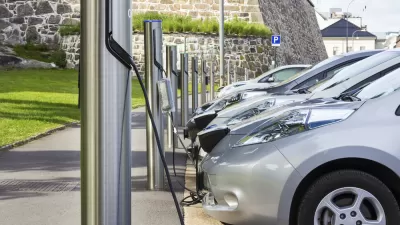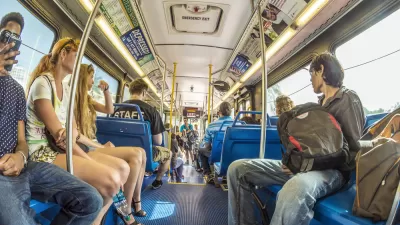The city's new transportation plan focuses on eliminating carbon emissions in its transportation sector, reducing congestion, and boosting public transit.

With its new Clean Transportation Electrification Blueprint, Seattle is embarking on an ambitious plan to electrify its transportation system and decrease congestion by boosting its EV charging network, encouraging more walking, biking, and transit ridership, and restricting private cars in parts of the city. But "these aspirations hinge on politically aligned values at all levels of government and cooperation with companies that have been hostile to regulations from the city," writes Michelle Baruchman in the Seattle Times.
Building on "Seattle's Green New Deal, which seeks to eliminate the city’s climate pollution by 2030, address environmental inequities and create thousands of green, unionized jobs," the plan requires "aggressive" efforts and collaboration across sectors. According to the plan, by 2030, "all ride-hailing trips would be electric and emissions free; almost one-third of deliveries would be made with vehicles that don’t emit carbon; a 'major area' of Seattle would be restricted to most cars; and charging stations would be reliable and readily available throughout the city."
The plan, which also includes congestion pricing for downtown Seattle, joins other efforts in Washington to reduce carbon emissions and improve public transit. "Washington State Ferries plans to convert its Wenatchee vessel from running solely on diesel fuel to using hybrid/electric power later this year," and "King County Metro has pledged to make its 1,500-bus fleet carbon free by 2040."
FULL STORY: ‘Major area’ of Seattle could forbid most cars under city’s new, greener transportation plan

Alabama: Trump Terminates Settlements for Black Communities Harmed By Raw Sewage
Trump deemed the landmark civil rights agreement “illegal DEI and environmental justice policy.”

Planetizen Federal Action Tracker
A weekly monitor of how Trump’s orders and actions are impacting planners and planning in America.

How Atlanta Built 7,000 Housing Units in 3 Years
The city’s comprehensive, neighborhood-focused housing strategy focuses on identifying properties and land that can be repurposed for housing and encouraging development in underserved neighborhoods.

In Both Crashes and Crime, Public Transportation is Far Safer than Driving
Contrary to popular assumptions, public transportation has far lower crash and crime rates than automobile travel. For safer communities, improve and encourage transit travel.

Report: Zoning Reforms Should Complement Nashville’s Ambitious Transit Plan
Without reform, restrictive zoning codes will limit the impact of the city’s planned transit expansion and could exclude some of the residents who depend on transit the most.

Judge Orders Release of Frozen IRA, IIJA Funding
The decision is a victory for environmental groups who charged that freezing funds for critical infrastructure and disaster response programs caused “real and irreparable harm” to communities.
Urban Design for Planners 1: Software Tools
This six-course series explores essential urban design concepts using open source software and equips planners with the tools they need to participate fully in the urban design process.
Planning for Universal Design
Learn the tools for implementing Universal Design in planning regulations.
Jessamine County Fiscal Court
Caltrans
Institute for Housing and Urban Development Studies (IHS)
City of Grandview
Harvard GSD Executive Education
Toledo-Lucas County Plan Commissions
Salt Lake City
NYU Wagner Graduate School of Public Service





























